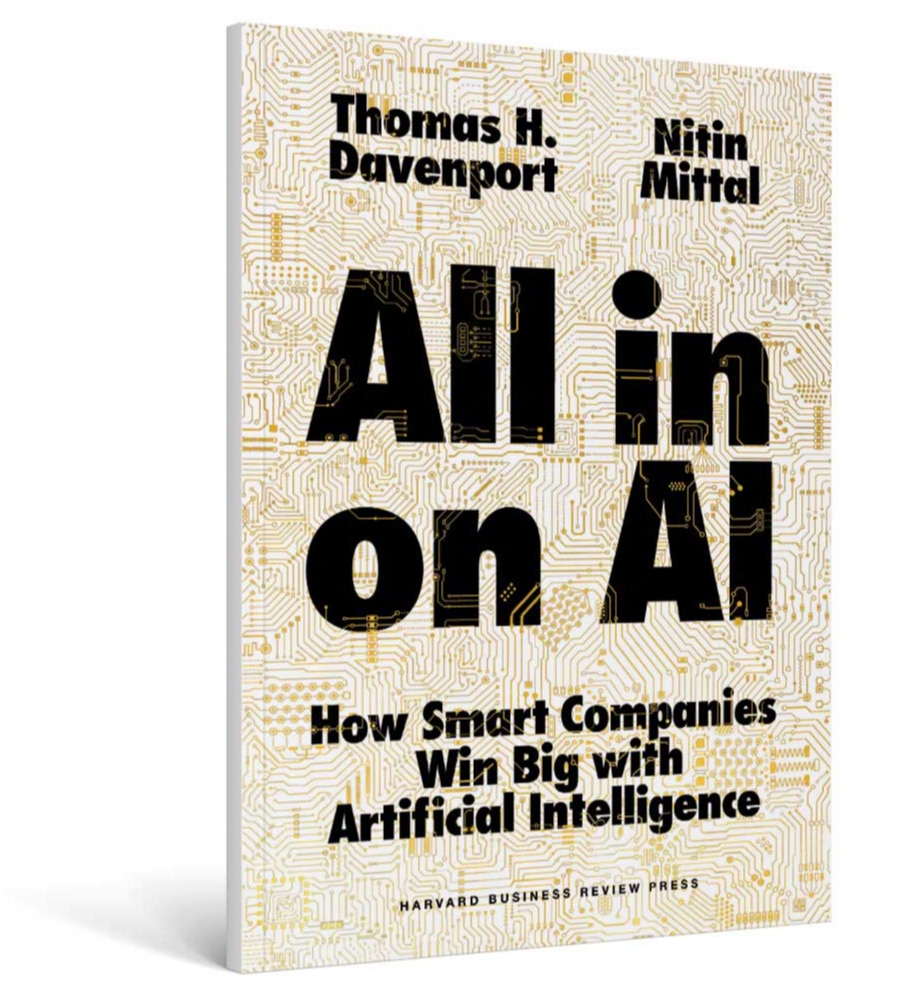
Por:
» THOMAS H. DAVENPORT, President’s Distinguished Professor of Information Technology & Management, Babson College (MA)
» NITIN MITTAL, Principal, Deloitte Consulting LLP (MA)
Companies worldwide have witnessed the advent and implementation of artificial intelligence. However, not all have embraced the change in their organizations to the same extent. In their book All-in on AI: how smart companies win big with artificial intelligence, experts Thomas H. Davenport and Nitin Mittal, Professor at Babson College and Principal with Deloitte Consulting, respectively, argue that businesses that have integrated AI into their production processes have gained a significant competitive advantage. This technology adds more value in managing increasingly complex supply chains.
How all-in-on-AI companies achieve value
The value levers that AI-fueled companies use to create more value than many other companies are:
- Speed to execution. Apply AI to accelerate time to operational and business results by minimizing latency in decision-making and action.
- Cost reduction. Apply AI to intelligently automate business processes, tasks, and interactions to reduce cost, increase efficiency, enhance environmental sustainability, and ensure predictability.
- Comprehend complexity. Apply AI to improve understanding and decision-making by deciphering patterns, connecting dots, and predicting outcomes from increasingly complex data sources.
- Transformed engagement. Apply AI to change how customers and employees interact with smart systems to expand means of engagement via voice, vision, text, and touch.
- Fueled innovation. Apply AI to generate deep insights on “where to play?” and “how to win?” enabling the creation of new products, market opportunities, and business models.
- Fortified trust. Apply AI to secure one’s brand from risks such as fraud, waste, abuse, and cyber intrusion, consequently assuring stakeholders and enhancing trust amongst customers.
Suffice it to say here that AI-fueled companies often use multiple levers — sometimes in the same use case — to improve their businesses.
It’s not just technology that creates organizational learning machines. It’s the combination of organizational DNA and a corporate culture that’s supportive of AI
Of course, the more value achieved, the better. Companies that wish to succeed with AI should employ as many different value levers as possible and strive to achieve multiple levers with individual use cases. Some of the levers, such as cost reduction, are relatively easy to measure. However, companies should not restrict themselves just to AI use cases that are easily measured. Some of the greatest benefits may arise from AI that changes the business model, makes decisions based on greater amounts and more complex types of data, and builds trust.

Where are companies on their journeys to all-in?
Having read about all the components of an AI-fueled company, you probably feel that your organization has some but not all of them, or that you’re making progress toward these attributes but aren’t fully there. The characterizations below may help you assess where you are.
- AI-fueled. All or most of the components we’ve described above, fully implemented and functioning — the business is built on AI capabilities and is becoming a learning machine (see below).
- Transformers. Not yet AI-fueled but relatively far along in the journey with some of the attributes in place; multiple AI deployments that are creating substantial value for the organization.
- Pathseekers. Already started on the journey and making progress, but at an early stage — some deployed systems and a few measurable positive outcomes achieved.
- Starters. Experimenting with AI — they have a plan but need to do a lot more to progress; very few or no production deployments in place.
- Underachievers. Have started experimenting with AI but have no production deployments and have achieved little to no economic value.
Becoming an organizational learning machine
One way of summarizing all these attributes is to think of all-in-on-AI companies as organizational learning machines. In such businesses, many aspects of AI-related learning are institutionalized and well-oiled. They are organizational learning machines in at least two senses. First, they are continuously learning from their research and deployment of AI. They experiment and adopt rapid trial-and-error processes to extract lessons from what works and what doesn’t. They have, as our colleagues John Hagel and John Seely Brown put it, achieved “scalable learning.” Both the experimentation and the learning are important to being world-class at AI.
For example, Ping An, the China-based company that began in insurance and now has moved into a variety of financial services-associated business areas, has a large research group and hires many talented PhDs in computer science and related fields. The company’s founder, Peter Ma Mingzhe, is an art collector and suggested to the chief scientist, Jing Xiao, that an AI system that could create art and music might appeal to the organization’s extensive network of customers and partners. Xiao commissioned a small team to try to create paintings, musical compositions, and poetry by training a machine learning system on existing high-quality examples.

The experiment worked: the researchers were able to create high-quality art, music, and poems. The system was introduced to the world at the 2019 World Artificial Intelligence Conference and received positive press mentions. The music composition system even won an international award. Xiao told us in an interview that Ping An is working on business models that connect the arts AI system to different ecosystems of the group, such as using AI-created music for online medication or other health-care-related services. Meanwhile, his team learned about how to develop AI systems for businesses involving the subjective emotions or feelings of participants, as seen in activities such as trading in the securities market.
The other way in which AI-fueled companies become organizational learning machines relates directly to machine learning (at least the supervised form of it, which is by far the most common type in business). That technology makes predictions of unknown outcomes based on models trained on past data for which outcomes are known. It may sound a bit confusing, but companies that are organizational learning machines are constantly learning from their machine learning. What contemporary AI capability has essentially done is to make it possible and economical to productionize learning at scale and speed.
AI-fueled companies monitor their models to understand how successful their predictions are (often using a technology called machine learning operations). If the model stops making accurate predictions, the company uses new data to retrain the model and improve its predictions. In that way, the continuous training creates continuous learning and a more valuable model that fits the new data. In other words, if the world changes, the company’s predictive models change with it.
A true learning machine company would do this for a whole variety of models, or at least the important ones. Doing so suggests that the company believes its models are important business assets worthy of monitoring and improving, recognizes that model accuracy can drift over time, and knows that technologies are available to facilitate the process of model operations. These capabilities are exactly the type that an AI-powered company would want to cultivate.
Of course, organizational learning machines can learn continuously from other types of AI as well. DBS Bank, for example, implemented chatbots — initially at its digital bank in India — as a means of providing high-quality customer service with no waiting and 24-7 availability to bank customers. During a review of a service failure in 2016, management challenged the team to monitor the customer journey more closely and detect issues before they happen.
These companies are consistent, reliable, and indefatigable. Their focus on AI in transforming their business is as relentless as any well-performing machine
The challenge inspired the team to come up with a new customer science program for digibank in India where they would monitor the journeys of every single digibank customer on a real-time basis. They would proactively look for indications of when the customer was struggling with using the mobile app, develop the ability to intervene when that was happening, and give the customer options for how to proceed with their journey. The learning was successful, and the chatbot learnings were applied both in India and in the home market of Singapore.
The final meaning of the term organizational learning machine focuses on the fact that these companies are consistent, reliable, and indefatigable. Their focus on AI in transforming their business is as relentless as any well-performing machine. They invest in AI infrastructure such as feature stores (repositories of well-defined variables for use in machine learning models) and algorithm libraries that can be reused many times across the organization. They ensure that many employees are also continuous learners about AI. They treat AI not as a fad but as a very powerful tool that can make them dramatically more efficient and effective in the marketplace.
Of course, it’s not just technology that creates organizational learning machines. It’s the combination of organizational DNA, a corporate culture that’s supportive of AI and data-driven decisions, an attitude of continual experimentation and innovation, and engagement of employees, customers, and business partners in these pursuits. Human beings make these things happen, not data or algorithms or high-powered servers.
Thomas H. Davenport is the President’s Distinguished Professor of Information Technology & Management at Babson College, a Visiting Professor at Oxford’s Saïd Business School, a Research Fellow at the MIT Initiative on the Digital Economy, and a Senior Advisor to Deloitte Analytics. His best-selling books include Competing on analytics and Big data at work.
Nitin Mittal is a Principal with Deloitte Consulting LLP. He currently serves as the US Artificial Intelligence (AI) Strategic Growth Offering Consulting Leader and the Global Strategy, Analytics, and Mergers and Acquisitions Practice Leader.
Reprinted by permission of Harvard Business Review Press. Excerpted from All-in on AI: how smart companies win big with artificial intelligence by Thomas H. Davenport and Nitin Mittal. Copyright 2023 Deloitte Development LLC. All rights reserved.
